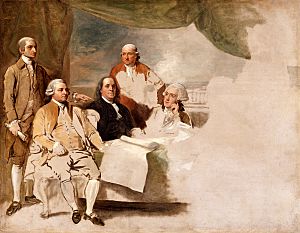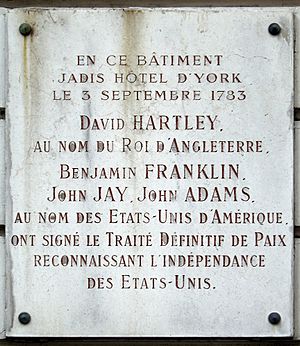Treaty of Paris (1783) facts for kids
| The Definitive Treaty of Peace Between the Kingdom of Great Britain and the United States of America | |
|---|---|

The first page of the Treaty of Paris, signed on September 3, 1783
|
|
| Drafted | November 30, 1782 |
| Signed | September 3, 1783 |
| Location | Paris, Kingdom of France |
| Effective | May 12, 1784 |
| Condition | Ratification by the Kingdom of Great Britain and the United States |
| Signatories | |
| Parties | |
| Depositary | United States government |
| Language | English |
The Treaty of Paris was a very important agreement. It was signed in Paris, France, on September 3, 1783. This treaty officially ended the American Revolutionary War.
It was signed by representatives from Great Britain and the United States. The treaty recognized the Thirteen Colonies as a new, independent country. These colonies had been part of British America.
The treaty also set the borders between British North America (which later became Canada) and the United States. These borders were considered very generous to the new United States. The agreement also covered things like fishing rights and the return of property and prisoners.
This treaty, along with other peace treaties, is sometimes called the Peace of Paris. These other treaties were between Great Britain and countries like France, Spain, and the Dutch Republic, who had helped the Americans. Today, only the first part of the treaty is still active. It states that the United States is a free and independent nation.
Contents
The Treaty of Paris: Ending the American Revolution


Peace talks started in Paris in April 1782. This was after George Washington and the Continental Army won the American Revolutionary War. The discussions continued through the summer of 1782.
The American team included Benjamin Franklin, John Jay, Henry Laurens, and John Adams. Representing Great Britain and King George III were David Hartley and Richard Oswald.
The treaty was written on November 30, 1782. It was signed on September 3, 1783, at the Hôtel d'York in Paris. Adams, Franklin, Jay, and Hartley all signed it.
How the Peace Treaty Was Agreed Upon
In September 1782, France's foreign minister, Vergennes, suggested a way to solve the talks. The United States rejected his idea. France was tired of the war, and everyone wanted peace. Only Spain wanted to keep fighting to capture Gibraltar from the British.
Vergennes' plan would have given Spain Gibraltar. The United States would become independent but stay east of the Appalachian Mountains. Britain would keep the land north of the Ohio River. An independent Native American state, controlled by Spain, would be south of that.
The American team felt they could get a better deal by talking directly with the British. John Jay told the British he wanted to negotiate without France and Spain. The British Prime Minister, Lord Shelburne, agreed.
Shelburne saw a chance to separate the United States from France. He also wanted the new nation to be a good trading partner. The deal was that the United States would get all the land east of the Mississippi River. This included land north of present-day Florida and south of present-day Canada. The northern border would be almost the same as it is today.
The United States also gained fishing rights near Nova Scotia. They agreed to let British merchants and Loyalists try to get their property back. This treaty was very good for the United States. Britain hoped for strong trade with the growing United States, which did happen.
Great Britain also signed separate agreements with France and Spain. They also made a temporary agreement with the Dutch Republic. In the treaty with Spain, East and West Florida went back to Spain. Spain also got the island of Menorca. However, the Bahama Islands, Grenada, and Montserrat were returned to Britain.
The treaty with France mostly involved trading captured lands. France gained the island of Tobago and Senegal in Africa. It also confirmed earlier fishing rights near Newfoundland. Dutch lands in the East Indies were returned by Britain. This was in exchange for trading rights for Britain.
The Congress of the Confederation was the new US government. It approved the Treaty of Paris on January 14, 1784. This happened in Annapolis, Maryland. Copies were sent to Europe for other countries to approve. British approval happened on April 9, 1784. The final versions were exchanged in Paris on May 12, 1784.
Key Points of the Treaty
The Treaty of Paris and other peace treaties are known as the Peace of Paris. Only Article 1 of the treaty is still in effect today. This article says that the United States is a free and independent nation. The US borders changed later, which is why other parts of the treaty are no longer used.
Here are some of the main points of the treaty:
- Introduction: It states the goal is to "forget all past misunderstandings" and have "perpetual peace."
- Article 1: Britain recognized the United States as free and independent. This included all thirteen former colonies. The British Crown gave up all claims to their government and land.
- Article 2: This set the borders of the United States. It included the lines between the US and British North America. Britain gave up land it used to own.
- Article 3: US fishermen gained fishing rights. They could fish in the Grand Banks and the Gulf of Saint Lawrence.
- Article 4: Both sides agreed that debts owed to people on either side must be paid.
- Article 5: The US Congress would "strongly suggest" that states return land taken from Loyalists.
- Article 6: The United States would stop taking property from Loyalists in the future.
- Article 7: All prisoners of war on both sides were to be set free. British property in the US was to remain with them.
- Article 8: Both Great Britain and the United States would always have access to the Mississippi River.
- Article 9: Any land captured after the treaty was signed would be returned without payment.
- Article 10: The treaty had to be approved within six months of its signing.
- End Note: "Done at Paris, this third day of September in the year of our Lord, one thousand seven hundred and eighty-three."
What Happened After the Treaty?
Historians often say the treaty was very generous to the United States. It gave them much larger borders. British generosity was based on a plan for strong economic ties. Giving the US the huge area west of the Appalachian Mountains was meant to help the US population grow. This would create good markets for British goods. Britain would not have to pay for military or administration there. The goal was for the United States to become a major trading partner. As the French Foreign Minister Vergennes said, "The English buy peace rather than make it."
Some things did not go smoothly after the treaty. The US lost protection from pirates in the Mediterranean Sea. Individual states did not follow the federal recommendations. For example, they did not return Loyalist property. The Colony of Virginia did not follow Article 4. It kept laws against paying debts to British lenders. Many Loyalists tried to get their property back, but most failed.
The actual map of North America did not exactly match the treaty details. The treaty set a southern border for the US. But the British-Spanish agreement did not set a clear northern border for Florida. Spain then used its control of Florida to block American access to the Mississippi River. This went against Article 8.
To the north, the treaty said the US border went west from the Lake of the Woods to the Mississippi River. But the Mississippi River does not go that far north. So, the line going west from the Lake of the Woods never reaches the river. Also, the treaty did not explain how the new border would control movement and trade.
The American diplomats hoped to make a trade agreement with Britain. This would fix some unfinished business from the Treaty of Paris. But this did not happen in 1784. Britain also did not leave forts in US territory quickly, as promised. British troops stayed at six forts in the Great Lakes region and two at Lake Champlain. They even built another fort in Ohio in 1794.
Britain said they stayed because the US government did not pay Loyalists for their losses. All these forts were eventually given up peacefully. This happened because of the Jay Treaty in 1794.
| Name | Present-day location |
|---|---|
| Fort au Fer | Lake Champlain – Champlain, New York |
| Fort Dutchman's Point | Lake Champlain – North Hero, Vermont |
| Fort Lernoult (including Fort Detroit) | Detroit River – Detroit, Michigan |
| Fort Mackinac | Straits of Mackinac – Mackinac Island, Michigan |
| Fort Miami | Maumee River – Maume, Ohio |
| Fort Niagara | Niagara River – Youngstown, New York |
| Fort Ontario | Lake Ontario – Oswego, New York |
| Fort Oswegatchie | Saint Lawrence River – Ogdensburg, New York |
See also
 In Spanish: Tratado de París (1783) para niños
In Spanish: Tratado de París (1783) para niños
- Confederation Period, the time in US history after the Revolutionary War
- Diplomacy in the American Revolutionary War
- History of the United States (1776–1789)
- List of United States treaties
- Ratification Day (United States)


